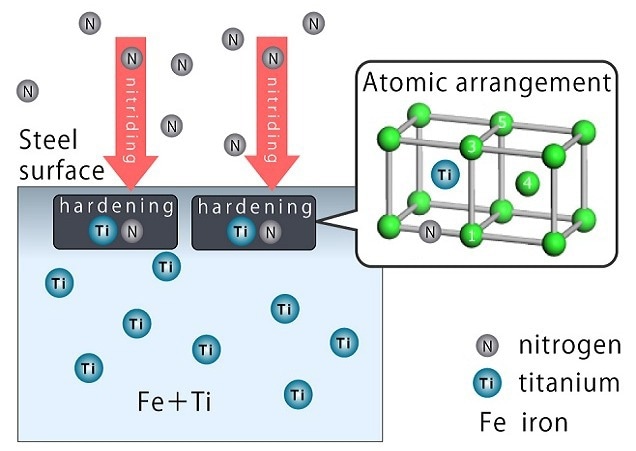Researchers at Osaka Metropolitan University published a study in ISIJ International that reveals how steel can be optimized for use in electric vehicles. Their calculations demonstrated that specific arrangements of titanium could be used to strengthen steel, leading to quieter and more durable electric car parts.

Model of the stable configuration of nitrogen and titanium in steel of iron-titanium alloy. Image Credit: Osaka Metropolitan University
Decarbonizing automobiles involves more than transitioning from gasoline engines to electric motors; it also requires the use of high-quality steel parts. These parts not only help the motors operate efficiently but also reduce the overall weight of the vehicles. High-performance steel materials provide quieter rides and are resistant to the wear and tear caused by the high-speed rotation of motors. To achieve this, it's crucial to optimize the process of enhancing the steel surface with carbon, nitrogen, and various alloy elements.
To better understand how different elements in steel interact, a research team from Osaka Metropolitan University, led by Associate Professor Tokuteru Uesugi at the Graduate School of Informatics, has conducted a comprehensive study. This team has theoretically calculated 120 possible interactions among 12 alloy elements, including aluminum and titanium, with carbon during the carburization process and with nitrogen during nitriding.
Their findings indicate that titanium, when positioned in a specific configuration, can effectively bond with nitrogen or carbon to strengthen the iron. Furthermore, the research data suggest that for an alloy element to bond effectively with iron, it should have a larger metallic radius than that of an iron atom.
Although it was not easy to elucidate the mechanism from the results of numerous calculations, we used multiple linear regression and stratified analysis through trial and error, these results are expected to contribute to a better understanding of the mechanisms of steel strengthening and improved durability, and to the development of superior materials.
Tokuteru Uesugi, Associate Professor, Graduate School of Informatics, Osaka Metropolitan University
This research was funded by the MEXT Program: Data Creation and Utilization Type Material Research and Development, Tokuteru Uesugi acknowledged the funding provided by the 29th ISIJ Research Promotion Grant, JSPS KAKENHI, JST under Collaborative Research Based on Industrial Demand “Heterogeneous Structure Control: Towards Innovative Development of Metallic Structural Materials,” and the Light Metal Educational Foundation.
Journal Reference:
Uesugi, T., et al. (2024) Interactions between interstitial and substitutional elements of solute diatomic and triatomic clusters in α-Fe from first-principles calculations. ISIJ International. doi.org/10.2355/isijinternational.isijint-2024-062.